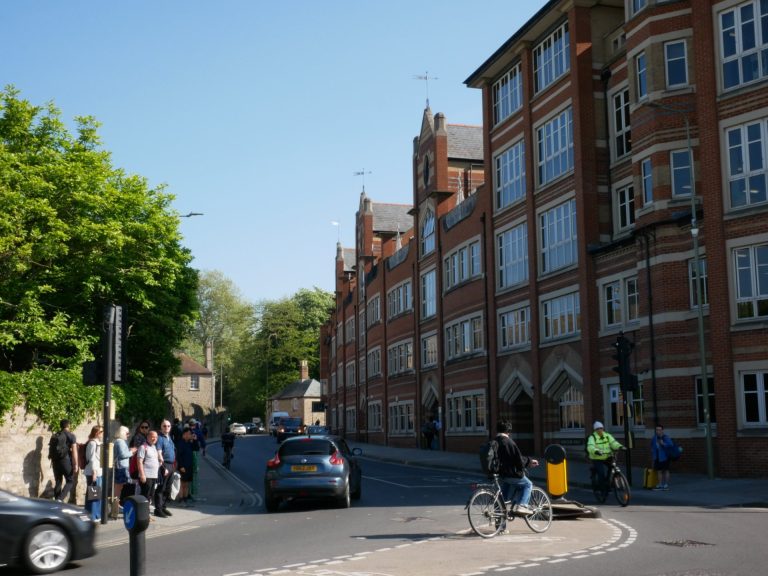Labyrinth Production’s upcoming production of Patrick Marber’s Closer is a novel step up in the kinds of physical and emotional intensity that the Oxford student drama scene has previously engaged with. The play follows the intertwined lives of Alice (Catherine ‘Catty’ Claire Williams-Boyle), Dan (Vasco Faria), Anna (Vita Hamilton) and Larry (Robert Wolfreys) in their flirtations, affairs, and entanglements with each other over the years, as they fall in and out of love again and again, breaking each other’s hearts.
Directed by Rosie Morgan-Males and produced by Natascha Norton, Closer brings a distinctly challenging level of intimacy for the cast and crew to contend with. Luckily, I had the chance to sit in on one of their rehearsals, and chat with the team about how they were able to deal with the difficulties.
From the moment I stepped into Cohen’s Quad in Exeter, it was clear that Rosie ran a strict rehearsal room, but the cast and crew were still very comfortable with each other; they jokingly reminded each other to “lock in, lock in” before the start of a scene. After one-and-a-half hours of intense rehearsal, in which the cast scream, fight, and betray each other in character, the return to a strong sense of camaraderie when we sat down for an interview, although abrupt to me, seemed to come very naturally to the cast.
When I asked them to talk about the scenes they had just been rehearsing, for example, Vasco started providing a comprehensive summary of the plot intricacies, before the other members of the cast started ribbing him to cut it short.
“I think from a dramaturgical point of view…” Rosie interrupted, as the rest of the cast laughed, “…it’s the first time that we see a scene that has all four [characters] in it. It’s the first time you can go, ‘oh, okay, I see two relationships side by side; how are they different, how are they going to cross?’”
“If Scene Five is like planting the seeds of the contracts that need to be made,” Catty also explained, “when you enter into Scene Six, those contracts are being finalized and you can see the dissolution of everything, which is then to be rebuilt in Act Two.”
The cast’s easy ability to transition from the heavy, emotionally intense scenes they’d been practicing to the light-hearted joking typical in rehearsal rooms was partly due to the help they’d had from a professional intimacy coordinator, Lex. Some of the cast had worked with her before on Labyrinth’s previous production, Julie. About this previous experience, Catty told Cherwell: “It makes you feel more comfortable, having someone to process your thoughts [with]… It’s easier for me to commit to what I have to do if I have this very professional presence guiding the room.”
For this play in particular, working with a coordinator had also improved their performances outside of specific intimate moments. “If you’re sort of fussing about leaning the right way and moving your hand here and there without feeling completely comfortable,” Vasco explained, “it can actually disrupt the rest of your performance because you’re too worried about that.”
Like line deliveries and stage blocking, moments of intimacy were also closely choreographed by the cast and crew. I got a first-hand insight into this during the earlier rehearsal, where the entire cast spent five minutes critically refining a brush of a hand across someone’s cheek. The level of attention to detail stood out to me, as well as the types of language these discussions contained; Rosie had an emphasis on asking how a scene ‘felt’ to actors, rather than just telling them how it looked.
This was also based on advice from the intimacy coordinator: “My favorite thing that Lex does, that not all intimacy coordinators do, is the ‘tap out’ at the end. …[When] you tap out, it’s not a conversation between me and the actors of ‘how did it look’; it’s a conversation between them in terms of ‘how did you feel in that moment?’
“It means that everyone is on that constant page of communication without shaming anyone if something slips up and goes wrong. It’s about putting precautions in place… Even if you’re not doing intimacy at that moment, the play is so emotionally vulnerable that it’s just a really good practice [to have] in place.”
Among other things, Closer boasts an all-star cast of OUDS BNOCs. Not only have many of them acted together in other major student productions, like Matchbox Production’s Moth and Clarendon Production’s Les Liaisons Dangereuses, but their skills as actors have already been well-recognised, and are particularly well-suited for this play.
“I just want to make people feel things, you know,” Rosie explained. “And I think we have a really strong pool of actors who are really good at this psychological-realism [in] theatre.”
Because of this, the staging for this production of Closer has been deliberately stripped-back, allowing the audience to focus on the lust, tension, love, and betrayal between the four characters in the play. In Rosie’s words: “It’s a real actors’ play. They don’t really have anything to hide behind.” I asked if this stylistic choice, or any of their acting choices, had been affected by previous performances of the cult classic; many of them had watched the movie before, but felt that this production was still distinctive.
“There’s a lot of stretch with the characters,” Rob said. “They’re a bit like archetypes and hopefully we’re doing something more fresh.
“I grew up with it being one of my favourite films, but… I don’t feel particularly attached to it,” Vita agreed. “[This production] does feel nice and fresh and like we’re building something new.”
When I asked what highlights the audience might be able to look for, there were audible groans from all of the cast.
“Every single scene?” Rosie suggested.
For many of them, it seemed to be the play’s realism that stood out most. “It’s not boring, but it is long,” Vita promised, “and there are only four characters, there’s not a [big] set, so you really do just sit with [the story].”
“Which I think is one of the most cathartic experiences you can have,” Rosie added. “When else does that happen?”
For Vasco, it was the time scale of the play that was unique: “It spans across 10 years, and [you’re] getting snapshots of key events. It feels like you’re living a whole lifetime with them… For the audience – we’re young, we’re students, we have our whole life ahead of us – it’s a cool way to see what’s going to happen.” After this response, he seemed to remember the full events of the play, and jokingly added, “Hopefully not quite that.”
Aside from a forward-looking view, Closer also seemed to reflect past experiences that audience members might share. “No matter who comes to see it, they’ll find a character that they intensely relate to and identify with,” Catty told Cherwell. “And I think that everyone will leave having felt a bit like something in their life was just represented for them.”
“If you’ve ever been broken up with or broken up with someone,” came the final word from Rosie, “this play is literally for you.”
Labyrinth Production’s staging of Closer will be running at the Michael Pilch Studio from 21st-24th May.











